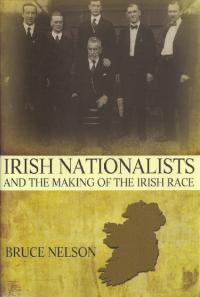Irish nationalists and the making of the Irish race
Published in 18th–19th - Century History, 20th-century / Contemporary History, Book Reviews, Issue 6 (Nov/Dec 2012), Reviews, Volume 20
Irish nationalists and the making of the Irish race
Bruce Nelson
(Princeton University Press, $45)
ISBN 9780691153124
Bruce Nelson starts his book with a clear statement: ‘this book is about race’. Over 257 pages he describes how Irish nationalists developed their own conception of the Irish race in the nineteenth and early twentieth centuries. He does this in an enjoyable, well-written and thought-provoking way.
Nelson traces how in the nineteenth century ‘race was everything’. Before developing his thesis he looks at how the Irish were viewed by the English from the twelfth century onwards as stubborn, feckless, savage and uncivilised. In particular he focuses on the work of L. Perry Curtis Jr and how in the nineteenth century the caricature of the Irish developed from an object of good-natured contempt to one of fear and loathing.
After examining these foreign views of the Irish, Nelson examines how the Irish defined themselves, often under conditions not of their choosing. More than four million people emigrated from Ireland between the Famine (1845–50) and the First World War (1914–18). Nelson points out that these events made Ireland an outward-looking society whose members defined their own identity in the places to which they emigrated: the United States, Britain, Australia, South Africa and other countries. Naturally many of those who lived abroad looked back to an ‘idealized holy Ireland’.
In the early nineteenth century, slavery and abolition dominated international politics. Nelson focuses on Daniel O’Connell, an outspoken opponent of slavery, and Frederick Douglass, who visited Ireland as a fugitive American slave in 1845. Douglass gave 50 lectures in Ireland, appearing at a Repeal meeting with O’Connell, who introduced him as ‘the black O’Connell of the United States’. Douglass felt that his time in Ireland enhanced his sense of dignity and that he could be free, but Nelson argues that he failed to come to terms with the reality of Irish society—most of his lectures were to well-educated Protestants. Back in New York in 1847 Douglass reported talking to a recently arrived Irish emigrant, who ‘gravely told me that it was his deliberate opinion that the coloured people . . . could never rise here and ought to go to Africa’.
O’Connell argued that nationalism was not just about Ireland but that all Irishmen ‘should be foremost in seeking to effect the emancipation of mankind’. In the 1840s O’Connell attempted to win over Irish-Americans to the cause of ending slavery (which many of them associated with British abolitionists). He failed because the newly arrived Irish in America perceived that to gain acceptance they needed to build a wall between themselves and African-Americans. The majority of Irish emigrants landed along the east coast in cities like Philadelphia, Boston and New York. This was reflected in the numbers of emigrants who fought in the American Civil War (1861–5): c. 150,000 for the Union Army and c. 50,000 for the Confederate Army. This need to create a division was more pronounced in the South, where a few Irishmen actually owned slaves and, when they did, normally worked alongside them in the fields. Purchasing a slave bestowed instant status in Southern society on the newly arrived Irish emigrants.
At the same time John Mitchel, a leading voice of the Young Ireland movement and later an 1848 revolutionary, was an outspoken supporter of the Confederacy and slavery when he lived there from 1855 to 1865. He admired the agrarian South as a latter-day version of a Greek republic and compared the industrial North with Britain. Later Arthur Griffith supported many of these views in a preface to the reprint of Mitchel’s classic Jail Journal. Nelson argues that many historians have used such examples to portray Irish nationalists as xenophobic and insular, and he writes about Irish nationalists such as Patrick Ford and Liam Mellows who do not fit this mould.
By the 1830s Irish soldiers made up 40% of the British Army, and it is often said that the Irish fought for the British Empire, the Scots ran it and the English kept the profits. Nelson looks at the Irish role in the British Empire, focusing on the experience of two individuals: Michael Davitt, founder of the Land League and a foreign correspondent at the time, and Erskine Childers, a soldier in the Anglo-Boer War in 1899. Nelson argues that Davitt romanticised the Boers as heroic victims of British imperialism. While Erskine Childers entered the war as an English patriot, he afterwards became pro-Boer and eventually an Irish nationalist, using his yacht, the Asgard, to import 900 rifles for the Irish Volunteers, landing them in Howth on 26 July 1914.
In the final part of the book Nelson looks at the class and nationalist struggles of the late nineteenth century. Ireland holds a strong attraction for Afro-Caribbean and African-American intellectuals, especially the epic story of suffering and regeneration. Nelson’s book is a timely chronicle of the quest by both foreigners and the Irish themselves to define and redefine race and identity. HI
Lar Joye is curator of military history at the National Museum of Ireland (Decorative Arts and History).
















